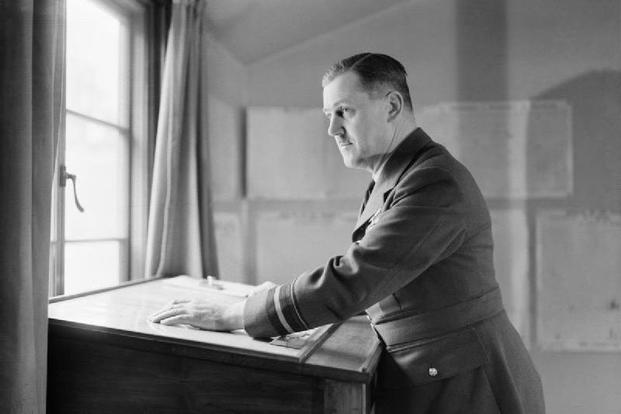Trafford Leigh-Mallory was born on Nov. 7, 1892 in Mobberly, Cheshire. Educated at Cambridge University, he graduated with honors after following a curriculum in history.
He served with the Territorial Battalion of the King's Regiment in 1914 at the outbreak of World War I and later received a commission in the Lancashire Fusiliers. In July 1916 he volunteered for service in the Royal Flying Corps.
When the Corps reorganized as the Royal Air Force in April 1918, he took command of an aerial reconnaissance squadron receiving the Distinguished Service Order (D.S.O.) and continuing on in this position through to the Armistice.
By 1937, with the clouds of war again gathering over Europe, Leigh-Mallory found himself in command of the RAF's 12 Group. During the Battle of Britain, 12 Group played a vital role in turning the tide of the air war and inflicting heavy losses on the Luftwaffe.
After the Battle of Britain, Leigh-Mallory took command of 11 Group which covered the airspace over London and southeast England. In 1942 Leigh-Mallory rose to Head of RAF Fighter Command, and by 1943 he became Commander-in-Chief of the Allied Expeditionary Air Forces (AEAF).
During the buildup to Operation Overlord there were differing opinions on the best method of utilizing the Allied air power in support of the invasion troops. Leigh-Mallory, as AEAF Commander in charge of all tactical airforces based in England, was characteristically outspoken in support of his "Transportation Plan". The "Transportation Plan" was an interdiction campaign that would encompass all Allied tactical and strategic air power and bring it to bear on the Axis forces throughout France and Germany. It had the singular purpose of targeting the transportation systems linking France and Germany. By solely targeting rail marshalling yards and associated service depots, Leigh-Mallory felt that German military traffic could be brought to a stand still. This would support the invasion by preventing German High Command from deploying its mobile reserve to the landing site at Normandy. Leigh-Mallory felt that by implementing the "Transportation Plan" ninety days prior to D-Day would allow the necessary time needed to saturate infrastructure targets across France and Belgium. By championing this approach Leigh-Mallory came into confrontation with Lt. General Carl 'Tooey' Spaatz, commander of the U.S. Strategic Air Force (USSTAF). Spaatz felt that the strategic bombing of aircraft factories and oil refineries was the quickest way to support an invasion and bring the Axis to its knees. After much debate on these courses of the air campaign, the 'Transportation Plan' finally received the approval of General Dwight D. Eisenhower, Supreme Allied Commander. Leigh-Mallory took command of all Allied air power, both tactical and strategic, for Operation Overlord. His coordination of these air assets against the railroads and military traffic traveling over them proved to be of incalculable value to the success of the D-Day invasion. By June 6, 1944, rail traffic was sufficiently interrupted as to pose a logistical nightmare to the defending German army and the Luftwaffe units in France had been decimated to a point where they posed little threat to the invasion force. Through the implementation of the 'Transportation Plan' as part of the overall invasion, combined with the failure of the German High Command to recognize Normandy as the actual invasion site, the Allied forces were able to establish a firm foothold on the Continent and begin the drive east to Berlin.
After the invasion of France, Leigh-Mallory was appointed Commander-in-Chief of the Allied Expeditionary Air Forces in South-East Asia in November 1944. Leigh-Mallory never took command of his new post, on Nov 18, 1944 his transport plane crashed in the French Alps killing all on board.















